Comparing Environmental Advisory Councils: How They Work and Why it Matters
Abstract
1. Introduction
2. Theory
2.1. How to Assess Advisory Councils: Fung’s Three Dimensions
2.2. From Defining Characteristics to Perceptions
2.3. The Specifics of Environmental Participatory Governance
3. Materials and Methods
4. Results
5. Discussion
Author Contributions
Funding
Acknowledgments
Conflicts of Interest
Appendix A
| Variables | Cramer’s V | Difference of Means | |||
|---|---|---|---|---|---|
| Environment | Education | Immigration | Sign. | ||
| The decision-making process in the council is fair and transparent | 0.155 *** | 4.42 | 5.35 | 5.39 | *** |
| Substantive scope of debates | 0.108 ** | 4.27 | 4.82 | 4.88 | *** |
| Feeling of being strongly involved with the process of advising | 0.108 ** | 4.65 | 5.08 | 5.02 | ** |
| The composition of the plenary is politically diverse | 0.077 | 4.99 | 5.40 | 5.54 | ** |
| All the important stakeholders are represented in the plenary | 0.124 *** | 5.18 | 5.75 | 5.43 | *** |
| Enough information is provided to make good decisions | 0.127 *** | 4.61 | 5.39 | 4.99 | *** |
| Information is diverse and unbiased | 0.131 *** | 4.37 | 5.14 | 4.90 | *** |
| Information is provided when requested | 0.130 *** | 5.12 | 5.85 | 5.52 | *** |
| Policy makers keep the council informed a | 0.122 *** | 3.25 | 3.45 | 3.91 | *** |
| The media pays attention to the issued advice a | 0.117 ** | 2.99 | 2.90 | 2.82 | - |
| Satisfaction with the quality of advice | 0.092 * | 4.51 | 4.96 | 4.91 | ** |
| The advice is clear | 0.129 *** | 4.91 | 5.51 | 5.28 | *** |
| The advice has great social support | 0.120 *** | 4.43 | 4.90 | 4.99 | *** |
| The advice represents the diversity | 0.094 * | 4.52 | 4.87 | 5.10 | ** |
| The administration is receptive towards the advice a | 0.088 | 3.56 | 3.70 | 4.00 | ** |
| Interaction between members proceeds constructively | 0.153 *** | 4.49 | 5.12 | 5.16 | *** |
| Interaction supports the development of consensus between members | 0.157 *** | 4.46 | 5.06 | 5.21 | *** |
| Members reach a consensus a | 0.145 *** | 3.25 | 3.67 | 3.67 | *** |
| There is good communication between members | 0.160 *** | 4.45 | 5.28 | 5.01 | *** |
| Variables | Statistically Significant Effect of Control Variables |
|---|---|
| Participatory process | |
| The decision-making process in the council is fair and transparent | Local level+ ***; council autonomy+ **; type of member: administration+ *; type of member: civil society- ** |
| Substantive scope of debates | Regional level+ **; local level+ **; type of member: administration+ *; type of member: civil society- *** |
| Feeling of being strongly involved with the process of advising | Type of member: administration+ ** |
| The composition of the plenary is politically diverse | Type of member: administration+ **; type of member: civil society- * |
| All the important stakeholders are represented in the plenary | - |
| Information | |
| Enough information is provided to make good decisions | Regional level+ **; local level+ **; council autonomy+ *; type of member: civil society- *** |
| Information is diverse and unbiased | Regional level+ **; local level+ ***; council autonomy+ **; type of member: administration+ **; type of member: civil society- *** |
| Information is provided when requested | Regional level+ *; local level+ **; type of member: civil society- *** |
| Policy makers keep the council informed a | Local level+ **; number of members- *; type of member: administration+ *** |
| The media pays attention to the issued advice a | Presence of administration+ * |
| Advice | |
| Satisfaction with the quality of advice | Regional level+ *; local level+ ***; council autonomy+ **; number of members+ ***; type of member: administration+ **; type of member: civil society- ** |
| The advice is clear | Regional level+ **; local level+ ***; council autonomy+ ***; type of member: civil society- ** |
| The advice has great social support | Regional level+ **; local level+ **; type of member: civil society- *** |
| The advice represents the diversity | Local level+ **; Type of member: administration+ *; type of member: civil society- ** |
| The administration is receptive towards the advice a | Regional level+ ***; local level+ ***; council autonomy+ **; type of member: administration+ ***; type of member: civil society- ** |
| Conflict | |
| Interaction between members proceeds constructively | Local level+ **; council autonomy+ *; type of member: administration+ ** |
| Interaction supports the development of consensus between members | Regional level+ *; local level+ **; council autonomy+ *; number of members+ *; type of member: administration+ *; type of member: civil society- * |
| Members reach a consensus a | Local level+ **; council autonomy+ **; type of member: civil society- ** |
| There is good communication between members | Regional level+ *; local level+ **; council autonomy+ **; type of member: civil society- ** |
References
- Eckersley, R. Deliberative democracy, ecological representation and risk: Towards a democracy of the affected. In Democratic Innovation: Deliberation, Association and Representation; Saward, M., Ed.; Routledge: London, UK; New York, NY, USA, 2000; pp. 117–145. [Google Scholar]
- Kuper, R. Deliberating waste: The hertfordshire citizens’ jury. Local Environ. 1997, 2, 139–153. [Google Scholar] [CrossRef]
- Smith, G. Deliberative Democracy and the Environment; Routledge: London, UK; New York, NY, USA, 2003. [Google Scholar]
- Abers, R.N. Organizing for governance: Building collaboration in Brazilian river basins. World Dev. 2007, 35, 1450–1463. [Google Scholar] [CrossRef]
- Fung, A. Varieties of Participation in Complex Governance. Public Adm. Rev. 2006, 66, 66–75. [Google Scholar] [CrossRef]
- Gerring, J. Mere description. Br. J. Political Sci. 2012, 42, 721–746. [Google Scholar] [CrossRef]
- Smith, G. Democratic Innovations: Designing Institutions for Citizen Participation; Cambridge University Press: Cambridge, UK, 2009. [Google Scholar]
- Cooper, T.; Musso, J. The potential for neighborhood council involvement in American metropolitan governance. Int. J. Organ. Theory Behav. 1999, 2, 199–232. [Google Scholar] [CrossRef]
- Schattan, V. Democratization of Brazilian health councils: The paradox of bringing the other side into the tent. Int. J. Urban Reg. Res. 2006, 30, 656–671. [Google Scholar]
- Fung, A. Empowered Participation: Reinventing Urban Democracy; Princeton University Press: Princeton, NJ, USA, 2004. [Google Scholar]
- Serdult, U.; Welp, Y. How Sustainable is Democratic Innovation? Tracking Neighborhood Councils in Montevideo. J. Politics Latin Am. 2015, 7, 131–148. [Google Scholar] [CrossRef]
- Navarro, C. Participatory democracy and political opportunism: Municipal experience in Italy and Spain (1960–93). Int. J. Urban Reg. Res. 2004, 28, 819–838. [Google Scholar]
- Christiansen, P.M.; Nørgaard, A.S.; Rommetvedt, H.; Svensson, T.; Thesen, G.; Öberg, P. Varieties of Democracy: Interest Groups and Corporatist Committees in Scandinavian Policy Making. Voluntas 2010, 21, 22–40. [Google Scholar] [CrossRef]
- Fobé, E.; Brans, M.; Vancoppenolle, D.; Van Damme, J. Institutionalized advisory systems: An analysis of member satisfaction of advice production and use across 9 strategic advisory councils in Flanders (Belgium). Policy Soc. 2013, 32, 225–240. [Google Scholar] [CrossRef]
- Reed, M.S. Stakeholder participation for environmental management: A literature review. Biol. Conserv. 2008, 141, 2417–2431. [Google Scholar] [CrossRef]
- Newig, J.; Challies, E.; Jager, N.; Kochskaemper, E.; Adzersen, A. The environmental performance of participatory and collaborative governance: A framework of causal analysis. Policy Stud. J. 2018, 46, 269–297. [Google Scholar] [CrossRef] [PubMed]
- López García, D. Mediation styles and participants’ perception of success in consultative councils: The case of Guadalajara, México. J. Public Delib. 2017, 13, 10. [Google Scholar] [CrossRef]
- Ward, H.; Norval, A.; Landman, T.; Pretty, J. Open citizens’ juries and the politics of sustainability. Political Stud. 2003, 51, 282–299. [Google Scholar] [CrossRef]
- Cornwall, A. Deliberating democracy: Scenes from a Brazilian municipal health council. Politics Soc. 2008, 36, 508–531. [Google Scholar] [CrossRef]
- Baber, W.F.; Bartlett, R.V. Deliberative democracy and the environment. In The Oxford Handbook of Deliberative Democracy; Bachtiger, A., Dryzek, J.S., Mansbridge, J., Warren, M.E., Eds.; Oxford University Press: Oxford, UK, 2018. [Google Scholar]
- Gastil, J.; Richards, R.C.; Ryan, M.; Smith, G. Testing Assumptions in Deliberative Democratic Design: A Preliminary Assessment of the Efficacy of the Participedia Data Archive as an Analytic Tool. J. Public Delib. 2017, 13. [Google Scholar] [CrossRef]
- Royo, S.; Yetano, A.; Acerete, B. E-participation and environmental protection: Are local governments really committed? Public Adm. Rev. 2014, 74, 87–98. [Google Scholar] [CrossRef]
- Font, J.; Blanco, I. Procedural legitimacy and political trust: The case of citizen juries in Spain. Eur. J. Political Res. 2007, 46, 557–589. [Google Scholar] [CrossRef]
- Font, J.; Navarro, C. Personal experience and the evaluation of participatory instruments in Spanish cities. Public Adm. 2013, 91, 616–631. [Google Scholar] [CrossRef]
- Fernández-Martínez, J.L.; García-Espín, P.; Jiménez-Sánchez, M. Participatory Frustration: The Unintended Cultural Effect of Local Democratic Innovations. Adm. Soc. 2019, 1–31. [Google Scholar] [CrossRef]
- Landwehr, C.; Holzinger, K. Institutional determinants of deliberative interaction. Eur. Political Sci. Rev. 2010, 2, 373–400. [Google Scholar] [CrossRef]
- Jiménez, S.M. El Impacto Político de los Movimientos Sociales: Un Estudio de la Protesta Ambiental en España; CIS, Colección Monografías: Madrid, Spain, 2005. [Google Scholar]
- Wironen, M.B.; Bartlett, R.V.; Erickson, J.D. Deliberation and the promise of a deeply democratic sustainability transition. Sustainability 2019, 11, 1023. [Google Scholar] [CrossRef]
- Bobbio, L. Designing effective public participation. Policy Soc. 2018, 38, 41–57. [Google Scholar] [CrossRef]
- Revel, M.; Blatrix, C.; Blondiaux, L.; Fourniau, J.M.; Hériard Dubreuil, B.; Lefebvre, R. Le Débat Public: Une Expérience Française de Démocratie Participative; La Decouverte: Paris, France, 2007. [Google Scholar]
- Fraussen, B.; Beyers, J.; Donas, T. The expanding core and varying degrees of insiderness: Institutionalised interests groups access to advisory councils. Political Stud. 2015, 63, 569–588. [Google Scholar] [CrossRef]
- Baiocchi, G.; Ganuza, E. Popular Democracy: The Paradox of Participation; Stanford University Press: Stanford, CA, USA, 2016. [Google Scholar]
- Jiménez, M. Sustainable Development and the Participation of Environmental NGOs in Spanish Environmental Policy. In Environmental Politics in Southern Europe; Eder, K., Kousis, M., Eds.; Environment & Policy, Springer: Dordrecht, The Netherlands, 2001; Volume 29, pp. 225–253. [Google Scholar]
- Font, N.; Subirats, J. Local y Sostenible. La Agenda 21 Local en España; Icaria: Barcelona, Spain, 2000. [Google Scholar]
- Font, J.; Pasadas, S.; Fernández-Martínez, J.L. Participatory Motivations in Advisory Councils: Exploring Different Reasons to Participate. Representation 2019, 1–19. [Google Scholar] [CrossRef]
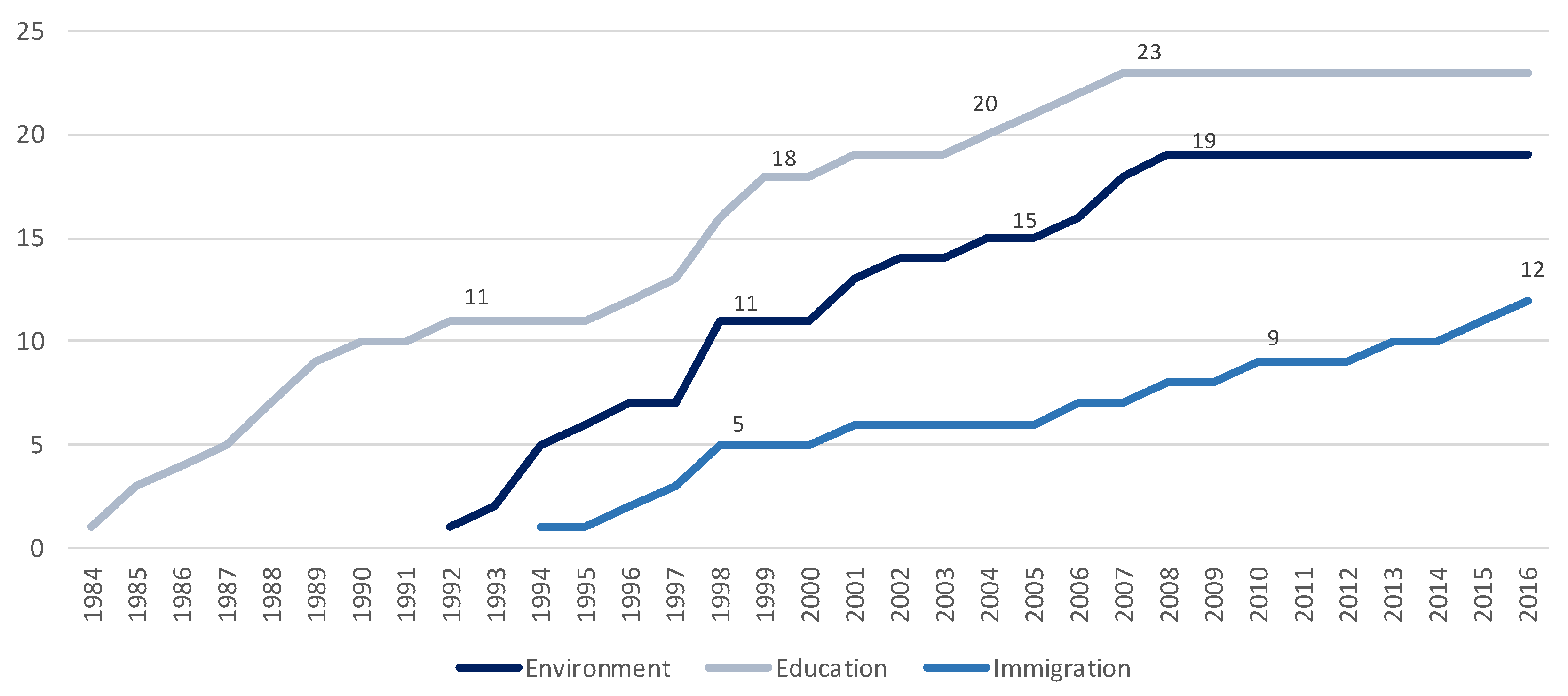
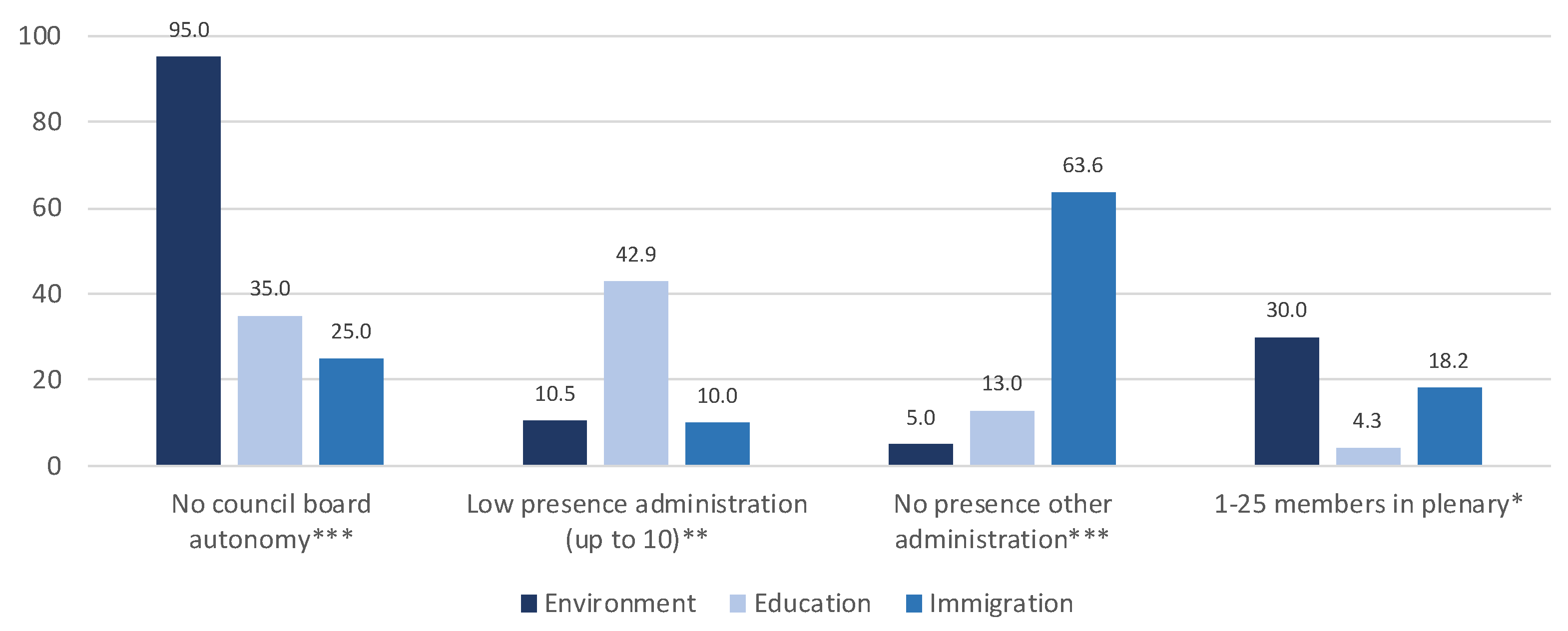
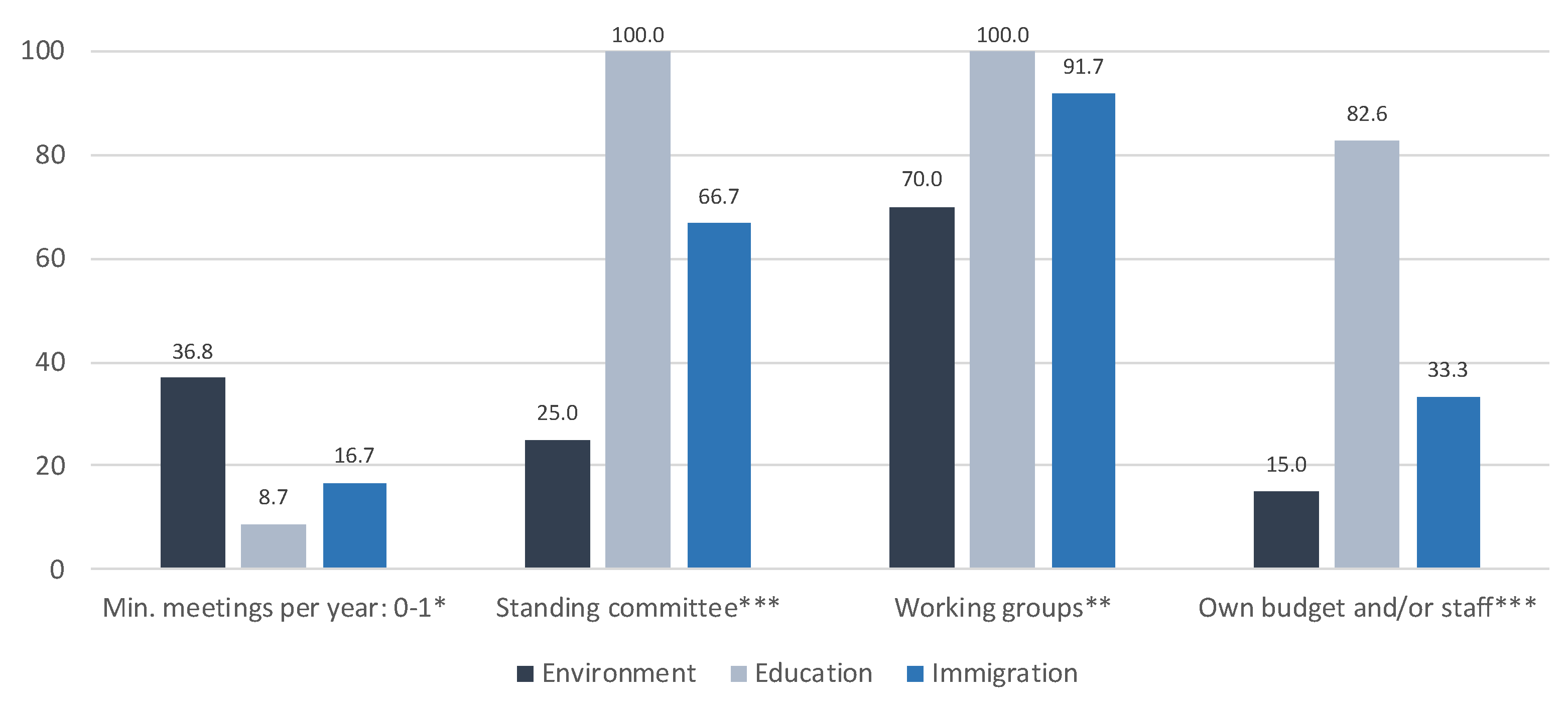
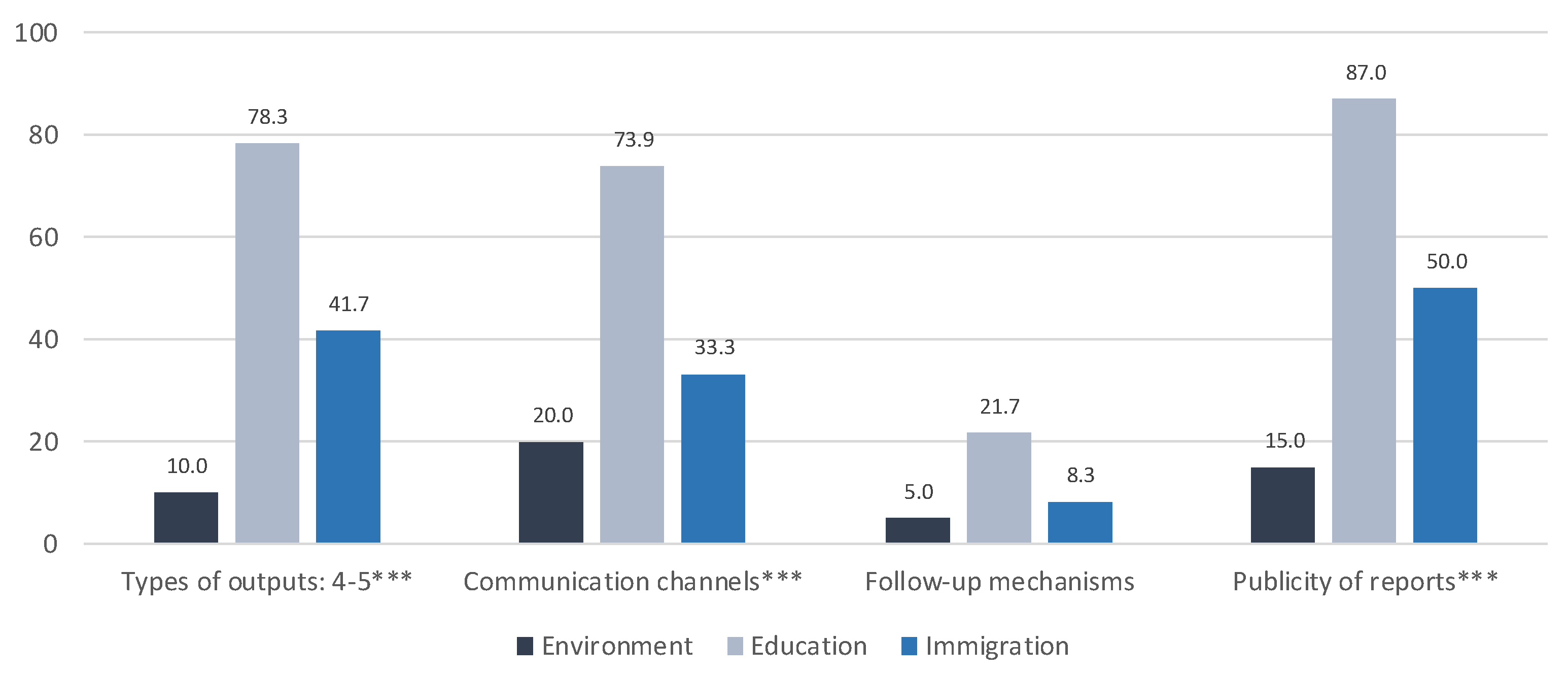
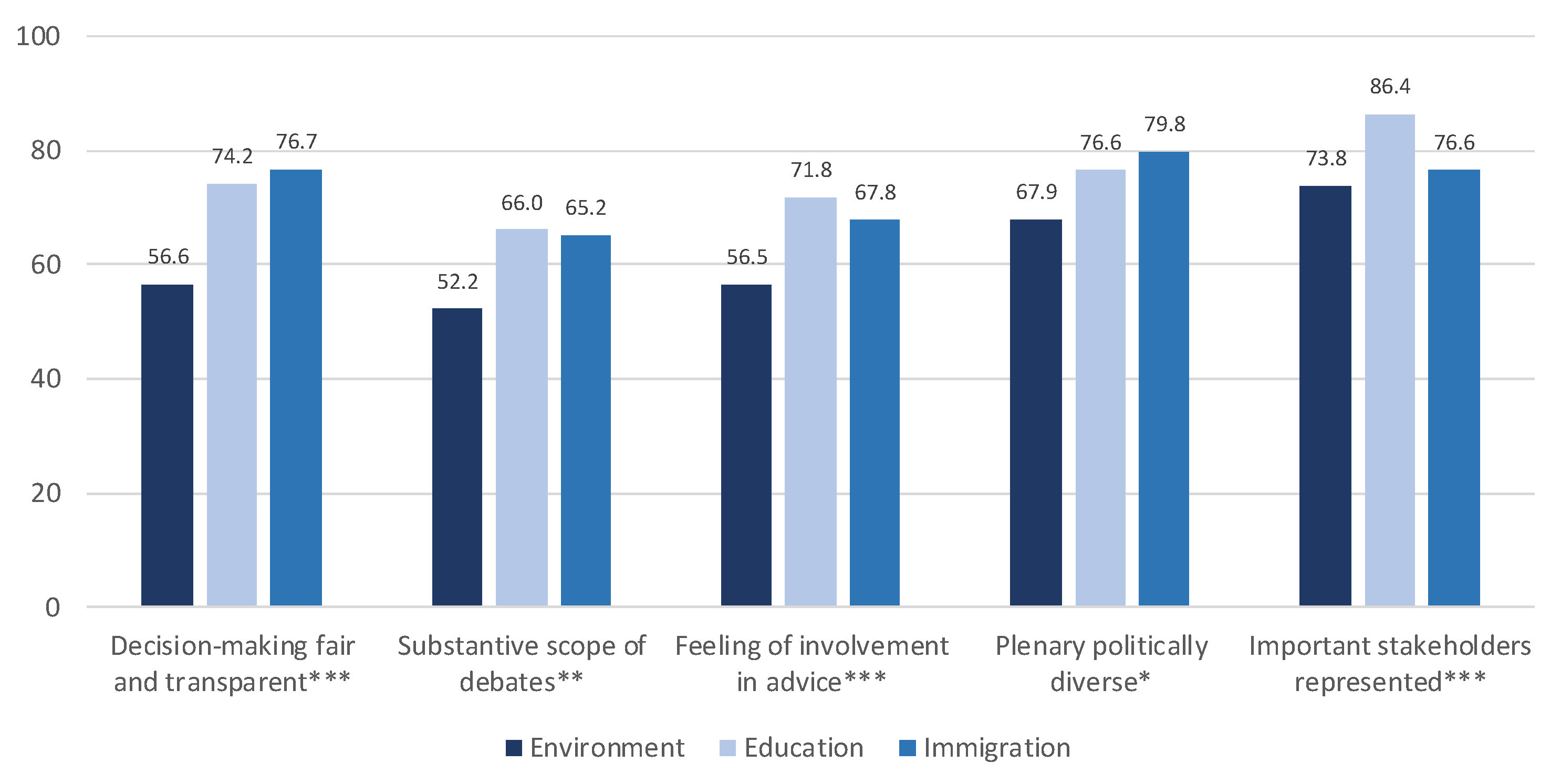
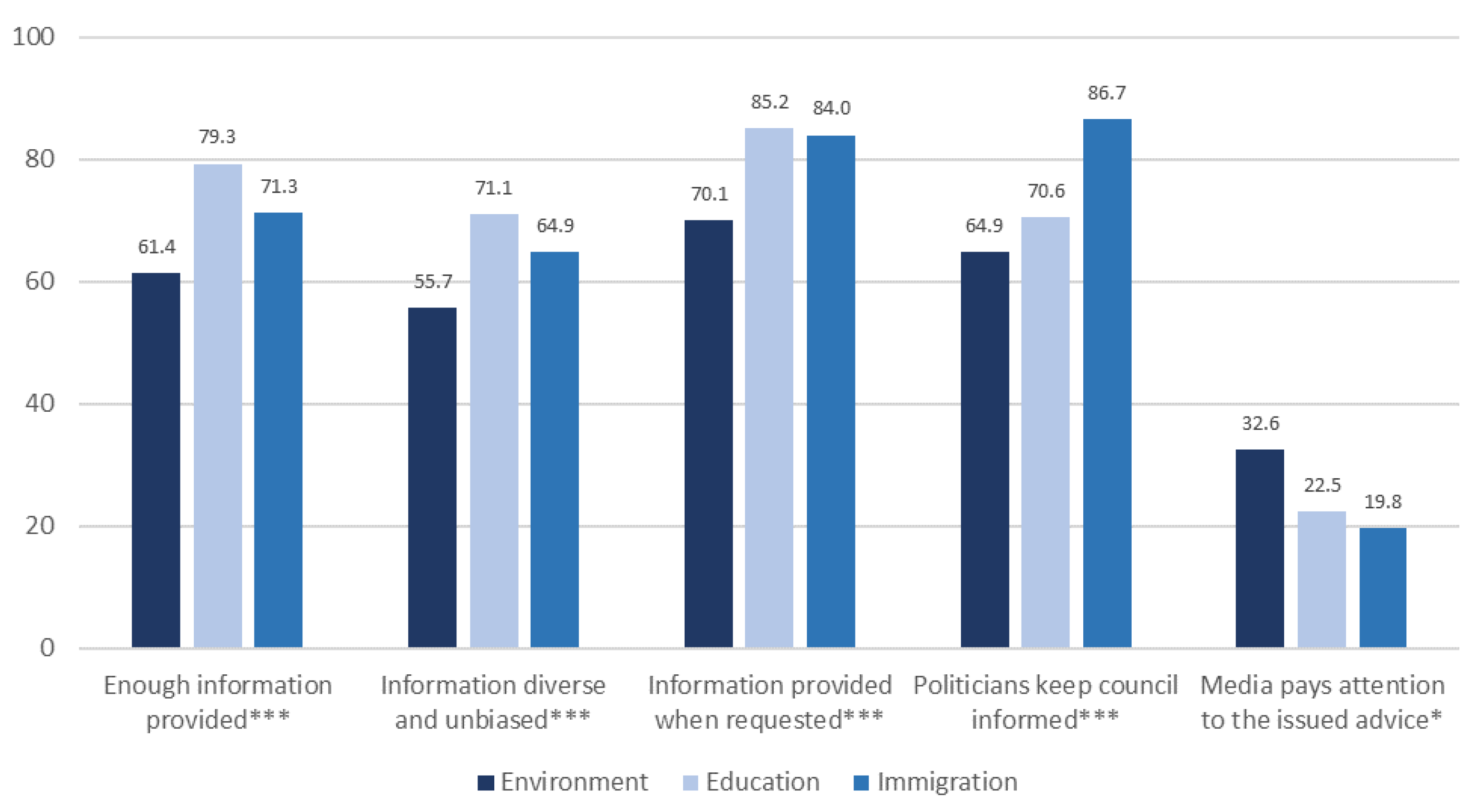
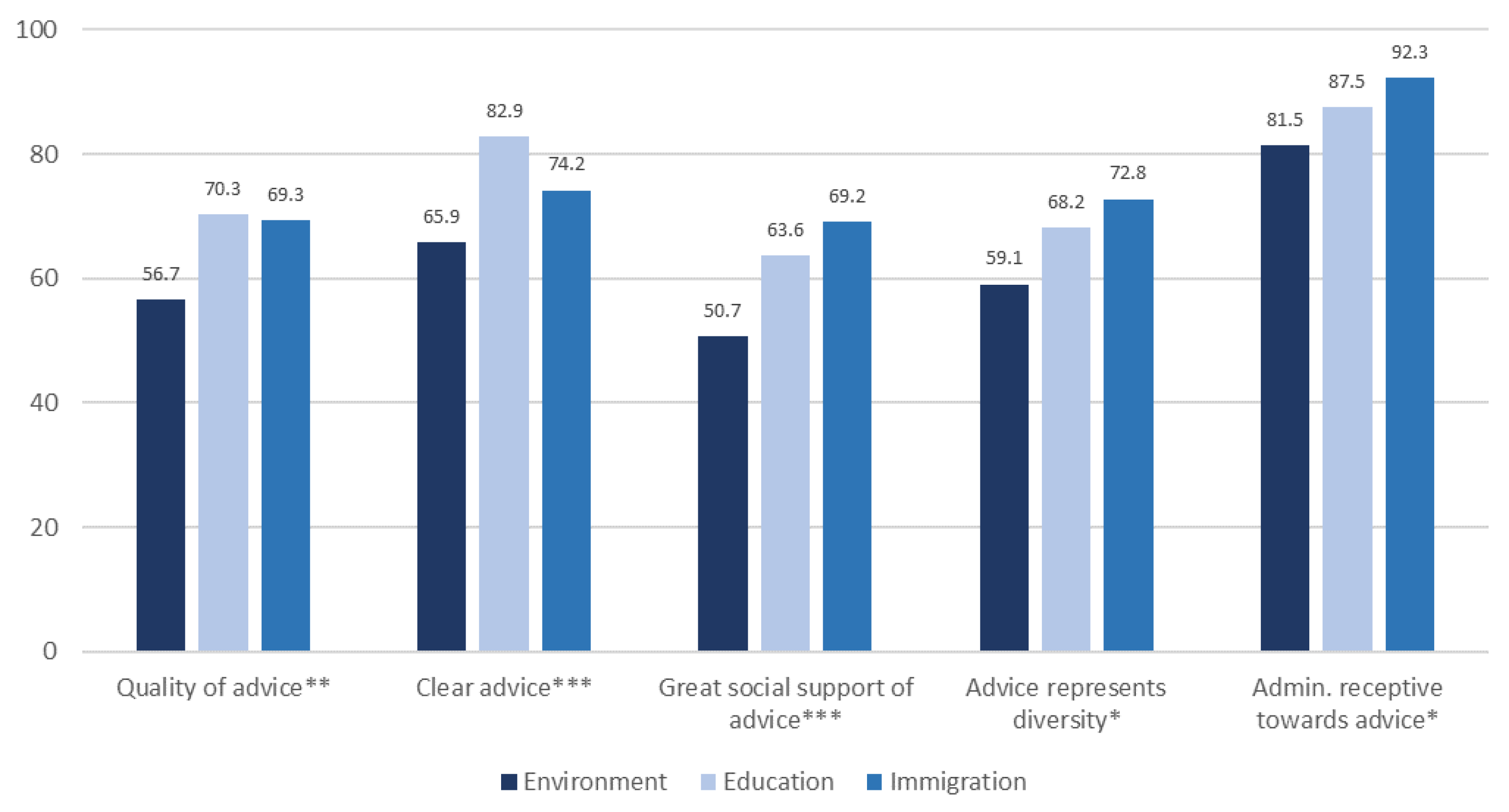
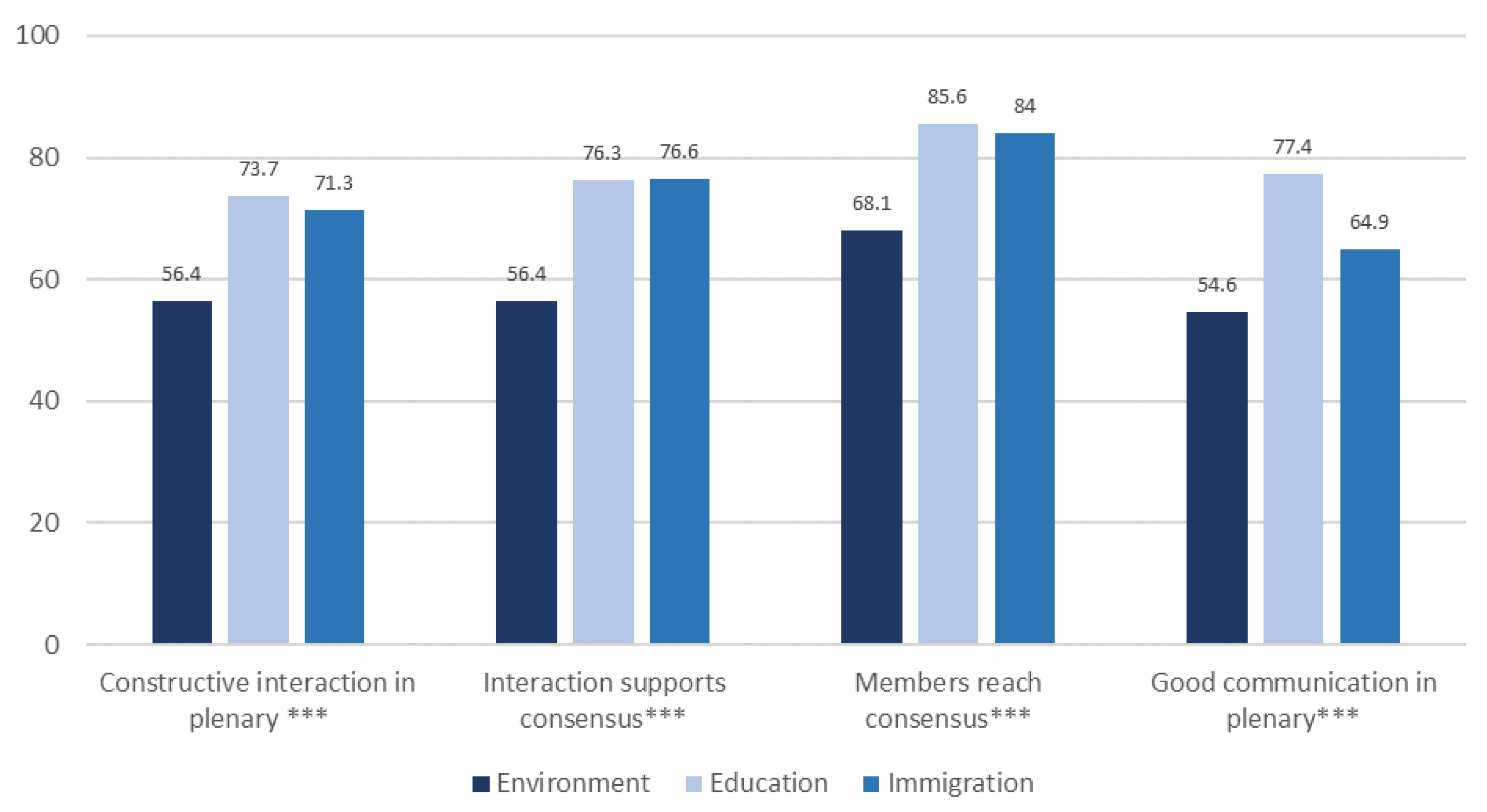
| Variables | Operationalization |
|---|---|
| Date of creation | Year of creation |
| Council board autonomy a | Quantitative: +3 President does not belong to public administration, +2 for 1st Vice-president and +1 for 2nd Vice-president Qualitative: 0 = No autonomy/1–6 = Autonomy |
| Presence of public administration | Quantitative: [Number of politicians + number of positions of trust + number of public officers] ÷ Total number of members in plenary Qualitative: Up to 10% = Low presence/More than 10% = High |
| Presence of other administrations | Quantitative: Number of representatives from other administrations ÷ Total number of members in plenary Qualitative: 0% = No presence/More than 0% = Presence |
| Total number of individual members in plenary | Quantitative: total number of members Qualitative: 1–25 members/More than 25 |
| Minimum number of ordinary meetings per year | 0-1 meetings per year/2 or more |
| Clear evidence of an independent budget or own staff b | Own budget or staff/None |
| Types of outputs c | Quantitative: Number of outputs or objectives Qualitative: 0–3 types of outputs/4–5 |
| Standing committee | Yes/no |
| Working groups or specialized commissions | |
| The rules specify the communication channels with public authorities | |
| Mechanisms for follow-up and assessing council proposals | |
| Public authorities are obliged to consult the council | |
| Reports and recommendations being publicly available (online) | |
| Social media profile (Twitter or Facebook) | |
| Presence on Twitter | Number of tweets mentioning the council in 2018 |
| Presence in El País newspaper d | Number of news mentioning the council in El País (the most important newspaper in Spain) |
| Variables | Operationalization |
|---|---|
| Type of member | Public administration (politicians or public officers)/Civil society (associations, NGOs, trade unions, citizens)/Others (experts, Universities) |
| The decision-making process in the council is fair and transparent | Quantitative: 7-point scale Qualitative: Yes (strongly agree, agree, somewhat agree)/ No (strongly disagree, disagree, somewhat disagree, neither agree nor disagree) |
| Feeling of being strongly involved with the process of advising | |
| The composition of the plenary is politically diverse | |
| All the important stakeholders are represented in the plenary | |
| Enough information is provided to make good decisions | |
| Information is diverse and unbiased | |
| Information is provided when requested | |
| The media pays attention to advice issued | |
| The advice is clear | |
| The advice has a great social support | |
| The advice represents the diversity | |
| Interaction between members proceeds constructively | |
| The interaction supports the development of consensus between the members | |
| There is good communication between members | |
| Substantive scope of debates | Quantitative: 7-point scale Qualitative: Yes (strongly satisfied, quite satisfied, somewhat satisfied)/ No (strongly dissatisfied, quite dissatisfied, somewhat dissatisfied, neither satisfied nor dissatisfied) |
| Satisfaction with the quality of advice | |
| Policy makers keep the council informed | Quantitative: 6-point scale Qualitative: Yes (always, almost always, often, sometimes)/ No (never/almost never) |
| The administration is receptive about the advice | |
| Members reach a consensus |
| Variables | Environment | Education | Immigration |
|---|---|---|---|
| The decision-making process in the council is fair and transparent *** | 1.852 | 1.466 | 1.420 |
| Substantive scope of debates *** | 1.707 | 1.462 | 1.536 |
| Feeling of being strongly involved with the process of advising * | 1.642 | 1.452 | 1.696 |
| The composition of the plenary is politically diverse *** | 2.044 | 1.749 | 1.584 |
| All the important stakeholders are represented in the plenary*** | 1.795 | 1.474 | 1.590 |
| Enough information is provided to make good decisions *** | 1.802 | 1.479 | 1.590 |
| Information is diverse and unbiased *** | 1.832 | 1.493 | 1.422 |
| Information is provided when requested *** | 1.665 | 1.381 | 1.435 |
| Policy makers keep the council informed a | 1.391 | 1.402 | 1.321 |
| The media pays attention to the issued advice a*** | 1.252 | 0.975 | 1.170 |
| Satisfaction with the quality of advice *** | 1.635 | 1.389 | 1.443 |
| The advice is clear *** | 1.499 | 1.132 | 1.297 |
| The advice has great social support | 1.397 | 1.234 | 1.346 |
| The advice represents the diversity *** | 1.632 | 1.505 | 1.351 |
| The administration is receptive towards the advice a | 1.255 | 1.137 | 1.145 |
| Interaction between members proceeds constructively *** | 1.720 | 1.336 | 1.547 |
| Interaction supports the development of consensus between members *** | 1.821 | 1.451 | 1.390 |
| Members reach a consensus a** | 1.278 | 1.111 | 1.186 |
| There is good communication between members *** | 1.779 | 1.419 | 1.688 |
| Dependent Variables | Independent var. | R2 | N | ||
|---|---|---|---|---|---|
| Educ. B coef. | Imm. B coef. | ||||
| Participatory process | The decision-making process in the council is fair and transparent | 0.633 *** | 0.692 *** | 0.137 | 478 |
| Substantive scope of debates | 0.313 | 0.453 ** | 0.099 | 477 | |
| Feeling of being strongly involved with the process of advising | 0.545 *** | 0.350 | 0.045 | 480 | |
| The composition of the plenary is politically diverse | 0.211 | 0.430 | 0.066 | 499 | |
| All the important stakeholders are represented in the plenary | 0.474 ** | 0.059 | 0.047 | 500 | |
| Information | Enough information is provided to make good decisions | 0.439 ** | 0.248 | 0.102 | 500 |
| Information is diverse and unbiased | 0.423 ** | 0.285 | 0.127 | 500 | |
| Information is provided when requested | 0.450 ** | 0.276 | 0.119 | 494 | |
| Policy makers keep the council informed a | 0.187 | 0.495 ** | 0.122 | 479 | |
| The media pays attention to the issued advice a | −0.008 | −0.114 | 0.055 | 488 | |
| Advice | Satisfaction with the quality of advice | 0.093 | 0.103 | 0.120 | 468 |
| The advice is clear | 0.282 * | 0.148 | 0.100 | 494 | |
| The advice has great social support | 0.398 ** | 0.494 ** | 0.084 | 488 | |
| The advice represents the diversity | 0.140 | 0.391 * | 0.091 | 490 | |
| The administration is receptive towards the advice a | −0.101 | 0.205 | 0.188 | 482 | |
| Conflict | Interaction between members proceeds constructively | 0.449 ** | 0.450 ** | 0.090 | 500 |
| Interaction supports the development of consensus between members | 0.232 | 0.576 ** | 0.088 | 500 | |
| Members reach a consensus a | 0.200 | 0.241 | 0.063 | 496 | |
| There is good communication between members | 0.502 ** | 0.323 | 0.097 | 501 | |
© 2020 by the authors. Licensee MDPI, Basel, Switzerland. This article is an open access article distributed under the terms and conditions of the Creative Commons Attribution (CC BY) license (http://creativecommons.org/licenses/by/4.0/).
Share and Cite
Alarcón, P.; Fernández-Martínez, J.L.; Font, J. Comparing Environmental Advisory Councils: How They Work and Why it Matters. Sustainability 2020, 12, 4286. https://doi.org/10.3390/su12104286
Alarcón P, Fernández-Martínez JL, Font J. Comparing Environmental Advisory Councils: How They Work and Why it Matters. Sustainability. 2020; 12(10):4286. https://doi.org/10.3390/su12104286
Chicago/Turabian StyleAlarcón, Pau, José Luis Fernández-Martínez, and Joan Font. 2020. "Comparing Environmental Advisory Councils: How They Work and Why it Matters" Sustainability 12, no. 10: 4286. https://doi.org/10.3390/su12104286
APA StyleAlarcón, P., Fernández-Martínez, J. L., & Font, J. (2020). Comparing Environmental Advisory Councils: How They Work and Why it Matters. Sustainability, 12(10), 4286. https://doi.org/10.3390/su12104286





